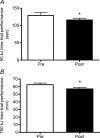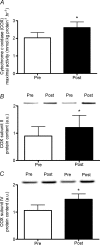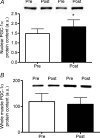A practical model of low-volume high-intensity interval training induces mitochondrial biogenesis in human skeletal muscle: potential mechanisms
- PMID: 20100740
- PMCID: PMC2849965
- DOI: 10.1113/jphysiol.2009.181743
A practical model of low-volume high-intensity interval training induces mitochondrial biogenesis in human skeletal muscle: potential mechanisms
Abstract
High-intensity interval training (HIT) induces skeletal muscle metabolic and performance adaptations that resemble traditional endurance training despite a low total exercise volume. Most HIT studies have employed 'all out', variable-load exercise interventions (e.g. repeated Wingate tests) that may not be safe, practical and/or well tolerated by certain individuals. Our purpose was to determine the performance, metabolic and molecular adaptations to a more practical model of low-volume HIT. Seven men (21 + or - 0.4 years, V(O2peak) = 46 + or - 2 ml kg(-1) min(-1)) performed six training sessions over 2 weeks. Each session consisted of 8-12 x 60 s intervals at approximately 100% of peak power output elicited during a ramp V(O2) peak test (355 + or - 10 W) separated by 75 s of recovery. Training increased exercise capacity, as assessed by significant improvements on both 50 kJ and 750 kJ cycling time trials (P < 0.05 for both). Skeletal muscle (vastus lateralis) biopsy samples obtained before and after training revealed increased maximal activity of citrate synthase (CS) and cytochrome c oxidase (COX) as well as total protein content of CS, COX subunits II and IV, and the mitochondrial transcription factor A (Tfam) (P < 0.05 for all). Nuclear abundance of peroxisome proliferator-activated receptor gamma co-activator 1alpha (PGC-1alpha) was approximately 25% higher after training (P < 0.05), but total PGC-1alpha protein content remained unchanged. Total SIRT1 content, a proposed activator of PGC-1alpha and mitochondrial biogenesis, was increased by approximately 56% following training (P < 0.05). Training also increased resting muscle glycogen and total GLUT4 protein content (both P < 0.05). This study demonstrates that a practical model of low volume HIT is a potent stimulus for increasing skeletal muscle mitochondrial capacity and improving exercise performance. The results also suggest that increases in SIRT1, nuclear PGC-1alpha, and Tfam may be involved in coordinating mitochondrial adaptations in response to HIT in human skeletal muscle.
Figures







Comment in
-
Exercise training for a time-poor generation: enhanced skeletal muscle mitochondrial biogenesis.J Physiol. 2010 Jun 1;588(Pt 11):1817-8. doi: 10.1113/jphysiol.2010.190199. J Physiol. 2010. PMID: 20516347 Free PMC article. No abstract available.
-
Just HIT it! A time-efficient exercise strategy to improve muscle insulin sensitivity.J Physiol. 2010 Sep 15;588(Pt 18):3341-2. doi: 10.1113/jphysiol.2010.196303. J Physiol. 2010. PMID: 20843832 Free PMC article. No abstract available.
Similar articles
-
Low-volume interval training improves muscle oxidative capacity in sedentary adults.Med Sci Sports Exerc. 2011 Oct;43(10):1849-56. doi: 10.1249/MSS.0b013e3182199834. Med Sci Sports Exerc. 2011. PMID: 21448086
-
High-intensity interval training increases SIRT1 activity in human skeletal muscle.Appl Physiol Nutr Metab. 2010 Jun;35(3):350-7. doi: 10.1139/H10-030. Appl Physiol Nutr Metab. 2010. PMID: 20555380
-
An acute bout of high-intensity interval training increases the nuclear abundance of PGC-1α and activates mitochondrial biogenesis in human skeletal muscle.Am J Physiol Regul Integr Comp Physiol. 2011 Jun;300(6):R1303-10. doi: 10.1152/ajpregu.00538.2010. Epub 2011 Mar 30. Am J Physiol Regul Integr Comp Physiol. 2011. PMID: 21451146
-
Metabolic adaptations to short-term high-intensity interval training: a little pain for a lot of gain?Exerc Sport Sci Rev. 2008 Apr;36(2):58-63. doi: 10.1097/JES.0b013e318168ec1f. Exerc Sport Sci Rev. 2008. PMID: 18362686 Review.
-
Deacetylation of PGC-1α by SIRT1: importance for skeletal muscle function and exercise-induced mitochondrial biogenesis.Appl Physiol Nutr Metab. 2011 Oct;36(5):589-97. doi: 10.1139/h11-070. Epub 2011 Sep 2. Appl Physiol Nutr Metab. 2011. PMID: 21888529 Review.
Cited by
-
Urine citrate and 6-sulfatoximelatonin excretion during a training season in top kayakers.Eur J Appl Physiol. 2012 Dec;112(12):4045-52. doi: 10.1007/s00421-012-2388-7. Epub 2012 Mar 31. Eur J Appl Physiol. 2012. PMID: 22466307
-
The Molecular Adaptive Responses of Skeletal Muscle to High-Intensity Exercise/Training and Hypoxia.Antioxidants (Basel). 2020 Jul 24;9(8):656. doi: 10.3390/antiox9080656. Antioxidants (Basel). 2020. PMID: 32722013 Free PMC article. Review.
-
Physiological and skeletal muscle responses to high-intensity interval exercise in Thoroughbred horses.Front Vet Sci. 2023 Nov 9;10:1241266. doi: 10.3389/fvets.2023.1241266. eCollection 2023. Front Vet Sci. 2023. PMID: 38026631 Free PMC article.
-
Post-exercise cold water immersion does not alter high intensity interval training-induced exercise performance and Hsp72 responses, but enhances mitochondrial markers.Cell Stress Chaperones. 2016 Sep;21(5):793-804. doi: 10.1007/s12192-016-0704-6. Epub 2016 Jun 8. Cell Stress Chaperones. 2016. PMID: 27278803 Free PMC article.
-
Intramuscular hematoma of the vastus lateralis following percutaneous skeletal muscle microbiopsy: a case report.Physiol Rep. 2021 Oct;9(19):e15038. doi: 10.14814/phy2.15038. Physiol Rep. 2021. PMID: 34633155 Free PMC article.
References
-
- Booth FW, Roberts CK. Linking performance and chronic disease risk: indices of physical performance are surrogates for health. Br J Sports Med. 2008;42:950–952. - PubMed
-
- Bruce CR, Anderson MJ, Carey AL, Newman DG, Bonen A, Kriketos AD, Cooney GJ, Hawley JA. Muscle oxidative capacity is a better predictor of insulin sensitivity than lipid status. J Clin Endocrinol Metab. 2003;88:5444–5451. - PubMed
Publication types
MeSH terms
Substances
Grants and funding
LinkOut - more resources
Full Text Sources
Other Literature Sources
Medical
Miscellaneous

